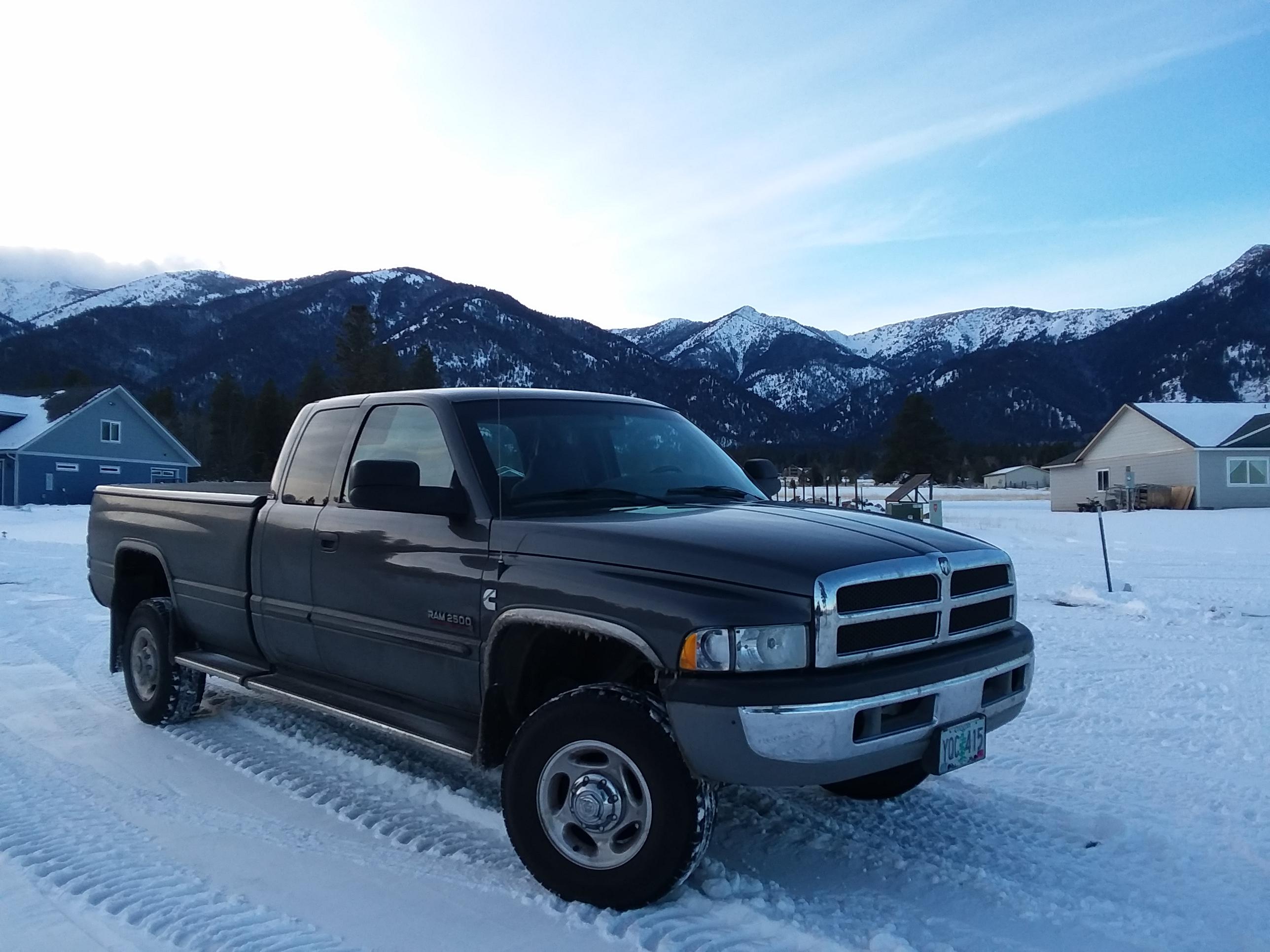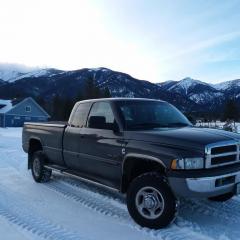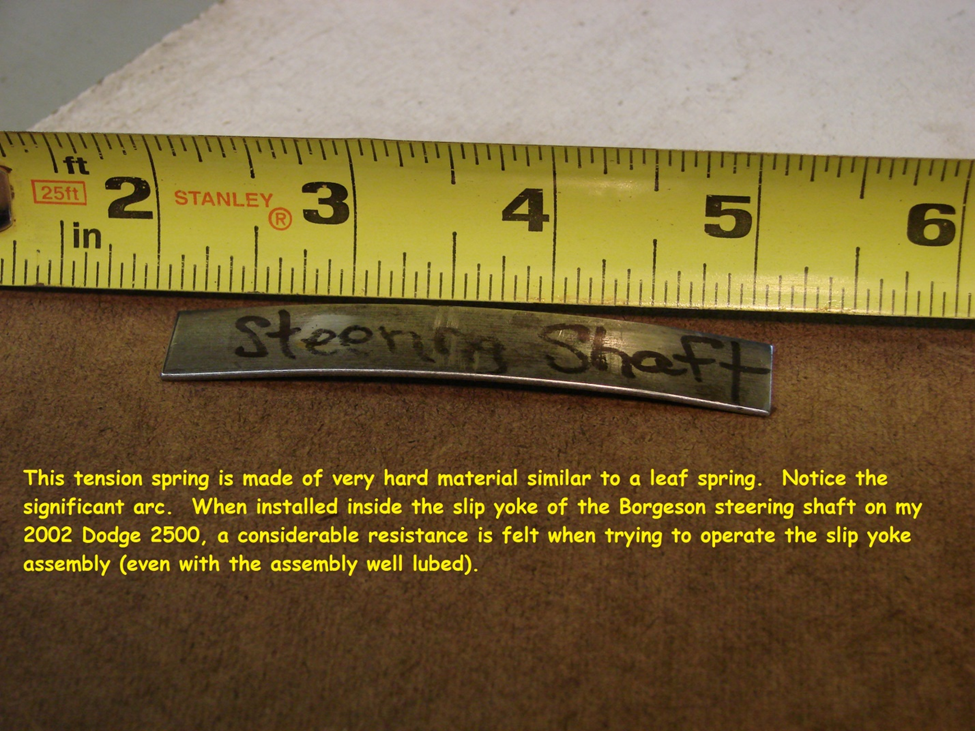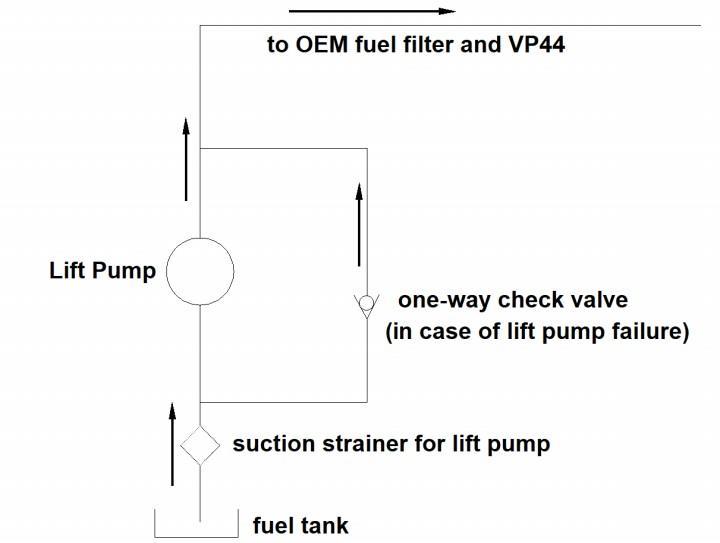
Everything posted by Tractorman
-
Grid Heater Delete
Here's my theory for here in the United States. Sometime back in the '70's, the big wigs of the Big Three (Ford, GM, and Chrlysler/Dodge) were having trouble deciding which direction to go - "metric" or "imperial". First one says, "Let's go with metric. It is much simpler and actually makes sense." The second one says, "I think we should stay with imperial. Everyone already knows it and to change tooling would cost a lot of money." After much discussion, the third one says, "Let's do both!" They all agreed unanimously, and it became law. - John
-
True HX35
If everything is working normal, I would think well over 20 psi boost should easily be attained at wide open throttle with a loaded truck on a Smarty tune. My truck has an HX35 with a blocked wastegate and I could easily attain 30 psi boost by 1800 rpm's on a mild Smarty tune when I had 300,000 miles on the OEM injectors. Something is amiss. - John
-
Borgeson steering shaft
Yes. Calling it a telescoping part is better terminology. A slip yoke or a telescoping part serve the same purpose - in this case to allow for axial movement of two joined steering shafts. Normally one would not think of movement between the cab and the truck frame, but there is because the cab is not rigidly fixed to the frame. This minor movement will cause varying degrees of axial movement at the telescoping point of the intersecting steering shafts. I think that others who use the Borgeson steering shaft may have or have had this same problem to a varying degree. It can be difficult to diagnose. You and one other that I have heard from have observed this particular problem. However, I have read of a few others that have had set screws that keep coming loose. I think that the friction in the telescoping part was likely the cause. It does make sense to me. The set screw would remain tight when rotational force is applied because there is a key or splines that absorb the rotational load. But when an axial force is applied (even a small one) it is the set screw that absorbs the load, thus working its way loose. Also, any axial force would negatively impact steering wheel operation. In my opinion, using multiple set screws to hold various steering shaft parts together is not a failsafe design for a steering mechanism. Most other designs incorporate a flexible joint fixed by hardware that can't allow for an unintentional disconnect of the any part of the steering shaft. - John
-
Borgeson steering shaft
Even keeping it lubed did not help me. I have had the Borgeson steering shaft for about 150,000 miles now. The first thirty thousand miles almost drove me nuts. It took 30,000 miles of driving to figure out that the slip yoke was binding - but not all of the time. When it did bind, you could hear a click and feel something in the steering wheel. When the symptoms occurred, the truck steered poorly. Also, set screws would come loose on the upper end of the upper steering shaft. I kept thinking other things were wrong with the steering. Finally, I disassembled the slip yoke. Each time thereafter when I disassembled the slip yoke, I would see a couple of places where the grease was completely wiped clean. I also noted that there was more friction than I thought there should to operate the slip yoke. The photo below shows a tension spring used in the slip yoke assembly. I even reduced the arc in the tension spring, but I still thought there was too much tension. I finally just removed the tension spring. From that time forward the steering completely changed. No noises, steering operation very smooth, and no more loose set screws ever, for the last 120,000 miles. After going through all of this, I am now fine with the Borgeson steering shaft. But, one needs to be diligent about checking the tightness of the set screws. The set screws will not loosen unless there is an underlying problem. In my case, the underlying problem was the random heavy axial load placed on both pieces of the steering shaft due to the high resistance in the slip yoke. Once I removed the resistance, all was well. - John 12-16-2021 Borgeson Steering Shaft.docx
-
Disappearing Brake Fluid
When the master cylinder is low, the fluid will be split into two separate reservoirs. One should have been empty and the other should have remained at the top level of the dividing wall. If you observed which one is empty, it would help you diagnose the problem. Be sure to check the rear brake line between the frame rail and the fuel tank. Since you live in the rust belt, your truck is a candidate for a brake line rusting through from the outside. - John
-
Suddenly didn't want to start.
That is the classic signature of air leaking into the fuel system while parked. Park the truck with nose facing uphill again with a 1/4 tank of fuel for a day or two. I will bet the problem will be back. With the truck parked on level ground or nose downhill with a relatively full fuel tank, the symptoms go away..., until the leak worsens. - John
-
Another radiator leak thread, this the season
Yes, you can do that. I did it when my OEM radiator began leaking at the plastic seam. You will lose coolant until the radiator seeks its own level - kind like old vertical flow radiators did before coolant overflow bottles. The top two rows will not have coolant flowing through them, but that is okay for an emergency. @Mopar1973Man's method is much better. No loss of coolant and 100% capacity of the radiator. - John
-
Melted battery terminal
@IBMobile and @Mopar1973Mancouldn't have said it better. I would disassemble, inspect and clean all of your battery connections and battery grounds. - John
-
Another radiator leak thread, this the season
As far as altering this valve permanently, this would not allow pressure to build in the cooling system. It is the high limit of the of the pressure relief valve in the radiator cap that allows coolant to reach a boiling point of approximately 245°. Cutting the valve for @Doubletrouble's situation is a good idea, especially since he wants to drive the truck while waiting for his new radiator. The coolant will pass back and forth to and from the overflow bottle without building pressure. T If he marks that cap and keeps it in the boonie box, then he will have a cap on hand in case it is needed again under a similar situation. I edited my post because I didn't like what I wrote the first time. - John
-
True HX35
It is going to take a long time to answer all those questions. Good questions, though. - John
-
True HX35
@Mopar1973Manprobably banned you from the site as a practical joke. Then he forgot to tell you..., - John
-
True HX35
There is something wrong here. You should easily see 30 psi boost with the Smarty S03 and stock injectors with an HX35. If I was in your shoes, I would be finding out what is wrong before I went to larger injectors or a different tuner. My truck has the original HX35 and I have blocked the wastegate. I have run the Smarty S03 for over 100,000 miles with 60,000 of those miles on the original stock injectors which I changed out to RV275's at 303,000 miles on the truck. 30 psi boost was easily attained even with the high mileage stock injectors. On another note - your signature says automatic transmission. Shouldn't there be an HY35 on the engine? Has the HX35 been modified in some way that maybe you don't know about? - John
-
Another new guy from Mtn Home
I am the original owner of my truck. The VP44 injection pump failed around year 2005 and Dodge warrantied the injection pump and also installed an in-tank lift pump to replace the block mounted lift pump. They installed a lift pump relay. All repairs were done under warranty. This was Dodge's fix for problem lift pumps and problem VP44's back then. I have since installed a frame mounted FASS lift pump, probably the same lift pump you mentioned. I used the existing relay for the lift pump operation. The main point is to reduce the electrical load through the ECM to extend the reliability and life of the ECM. So, whether or not you keep the old lift pump location or frame mount a different lift pump, it is important to wire in a relay for the lift pump. It is not as hard as you may think to properly wire in a frame mounted lift pump. I see that @IBMobilehas directed you to the appropriate article. - John
-
Another new guy from Mtn Home
@Bob the Builder, if the lift pump is still located in the factory position by the fuel filter housing, this means that the power supply for the lift pump is probably provided directly from the ECM. The FASS lift pump you are installing should be relayed and the coil portion of the relay triggered by the ECM. This will remove a considerable electrical load from the ECM. The switched portion of the relay should have a fuse between the relay and an unswitched power source. Also, the coil portion of the relay should be protected by an internal diode. - John
-
Radiator leak
Wow!! What lot of hassle to get something that should be easy to get! I would try to hold off using stop leak if you can. I used it once early in the life of my truck for about three years because of a leaking heater core. The heater core still leaked and slowly got worse. When I replaced the heater core, I could not get the coolant to clear up - even flushing and changing it out three times. I finally installed an external coolant filter system which cleaned it up in 3 weeks. My original radiator started leaking at the driver side tank seam at 309,000 miles. I replaced it with a NAPA radiator and it now has 50,000 on the new radiator and is doing fine. No issues with pulling 20,000 lbs combined weight over 6% grade mountain passes during the summer. - John
-
Who likes Bilsteins?
I have had Bilsteins 4600's for about 130,000 miles now (since 2015). They have worked out fine for me. The truck rides and handles good. I have heard that the 5100's are stiffer than the 4100's. You did not mention which shocks you have. - John
-
Fan Clutch Unscrewed Itself
My brother-in-law moved his 2003 2500 4wd NV5600 truck yesterday. While he was moving it, I noticed a ticking sound coming from under the hood. Upon investigation we found the whole clutch fan assembly laying in the bottom of the radiator shroud. Not what I expected. The unit had unscrewed itself from the threaded pulley hub. The interesting part is that there is hardly any damage. The large clutch fan nut shows witness marks where the outside of the crank pulley was rubbing and two fan blades show similar wear from rubbing on the crank pulley hub. The fan blades never contacted the radiator or anything else (including the fan clutch thermal switch and wiring harness), which was amazing. So, I am thinking that maybe the fan clutch was locked and the assembly came off when the engine was shut off; otherwise, I think the damage would have been much more severe. Anybody ever had this happen to them? We replaced the fan hub bearing in December, 2018, just over 20,000 miles ago. I used the proper wrenches to remove and reinstall the fan clutch. Most of my life I was a mechanic by trade and I have been around Dodge trucks and many other similarly equipped vehicles and I have never witnessed or heard of this happening. A new Mopar fan clutch and a new Dorman fan have been ordered. - John I just realized I posted in the wrong forum. Should be in the third generation powertrain forum. Maybe someone could move this post. Thank you, - John
-
Lift Pump Bypass for VP44 Trucks?
Thank you @W-T! That was the best compliment I could have ever received! - John
-
Lift Pump Bypass for VP44 Trucks?
Lift Pump Bypass for VP44 Trucks? The Modification – This subject matter might be a bit controversial, but I believe I have found a good solution regarding driving a VP44 equipped truck when a lift pump has failed while on the road. After I did an experiment for checking fuel return volume from the VP44 fuel injection pump on my truck, I realized that I came upon what I believe to be a simple solution to one of the biggest fears for VP44 truck owners - a lift pump failure while on a road trip. For the experiment I routed a fuel line with a one-way check valve around the lift pump so fuel would still flow when the lift pump was non-operational (simulating an electric lift pump failure). The reason I say “fuel would still flow” is because the VP44’s internal vane pump will draw the fuel into the VP44 injection pump. This lift pump bypass circuit includes a one-way check valve to flow fuel in a direction from the fuel tank to the stock filter housing. This lift pump bypass circuit on my truck is now a permanent circuit. Below is a diagram of the circuit. The Experiment - I arrived at a conclusion after experimenting with fuel return flow volume with or without an operational lift pump. The results of the experiment showed that fuel return volume did not change for either lift pump condition. Each test from the experiment showed averaged return fuel flows at approximately 19 gallons per hour, whether the lift pump was operating or not operating. The conclusion - My conclusion is that the lift pump only provides a positive pressure to the VP44 injection pump. It is the VP44 internal vane pump that takes over from here and supplies the fuel flow and operating pressure for all of the VP44’s internal components, including injector flow and fuel return flow for cooling. It is not just this experiment alone that helps me draw this conclusion. After much research over many years regarding the VP44 injection pump operation, and reading many posts from people who have done VP44 return flow volume testing with a flow meter, I am confident in my belief that the lift pump’s only job is to supply a positive pressure to the inlet of the VP44. The lift pump accomplishes this by providing more flow that the VP44’s internal vane pump can consume at any time. The VP44’s internal vane pump takes over from this point and provides flow and pressure to cover the needs for VP44 pump operation and cooling, which includes fuel flowing over the 14 psi overflow valve. The Test Drive - I test drove my truck for over 25 miles without the lift pump operating. My low pressure fuel indicator lamp remained on during the test drive. The truck drove fine. I shut the engine off and restarted it several different times. I applied wide open throttle several times. There were no performance issues during the test drive. If the lift pump failed on my truck on a road trip, I would not hesitate to continue driving the truck with this lift pump bypass circuit in operation. This simple fuel supply modification will allow a truck to continue to be driven with a lift pump failure. The VP44 internal vane pump will continue to supply fuel to the VP44 injection pump via the lift pump bypass circuit and will also continue to supply ample return fuel flow to the fuel tank for cooling the VP44. This modification could be a practical solution for those who drive trucks with a stock engine mounted or frame mounted lift pump. An in-tank lift pump bypass circuit would be more difficult to build, but would be doable. Lift Pump Bypass Operation - During normal lift pump operation, the one-way check valve will not allow fuel to return to the suction side of the lift pump. A fuel pressure gauge at the inlet of the VP44 pump will always register a positive pressure. With a lift pump failure, the fuel will pass through the free flow direction of the one-way check valve directing fuel around the lift pump into the VP44 pump inlet via the stock fuel filter housing. A fuel pressure gauge at the inlet of the VP44 pump will register zero at this time. There will actually be a small vacuum generated as the internal vane pump will be drawing fuel from the tank through the suction screen and fuel filter. What is important to note is that the same volume of fuel will be flowing through the VP44 injection pump and returning to the fuel tank as when the lift pump was operating. I am not recommending or suggesting that anyone perform this modification to their truck. However; personally, I am very confident that this modification will cause no harm to the VP44 injection pump should a lift pump failure occur. In fact, I believe the bypass circuit offers more protection to the VP44 pump than a circuit without the bypass feature simply because a failed lift pump could block or severely restrict the fuel supply circuit. I am posting this information on this particular site because, in my opinion, this site provides the best and most accurate information when it comes to second generation Dodge Cummins trucks, especially VP44 trucks. I say this with one exception – and that exception is: I don’t think this site has provided the best information on how the lift pump operates in conjunction with the internal vane pump inside the VP44 injection pump and how the 14 psi overflow inside of the VP44 injection pump interacts with the internal vane pump. I do think that members of this site go to a lot of effort to provide very useful information to solve problems for owners of Cummins equipped Dodge trucks and I am thankful for that. Any questions or comments will be appreciated. - John
-
Grid heater comes on when turning on lights.
@pwcracer, thank you for letting the forum know the cause of your problem. Your documentation once again shows the value of performing a voltage drop test. A ground connection that appears to be good visually and is tight mechanically does not necessarily mean that the connection is good enough to handle the electrical current passing through the connection.. For anyone interested, @Mopar1973Manhas written an article about the benefits of voltage drop testing and how to perform the test. One of the best things about performing this test is that the test is performed BEFORE disturbing the electrical connection in question. The results of voltage drop testing are always accurate. - John
-
Grid heater comes on when turning on lights.
Are you saying that an idling engine dies when you turn on the headlights? Even if the grid heaters are activated when the headlights are turned on, the engine still should not die. Can you be more specific about the symptoms your truck is having? Such as: How long has this problem been occurring? Does it occur every time? Did the problem start occurring just after any other repairs were done? What is indicating that the grid heater are on? Is the engine warm or cold when this happens? Etc. - John
-
Grid heater comes on when turning on lights.
Before pursuing any further, I would check all grounds for continuity. Any single poor ground at the right ground connection could give you the symptoms you are describing. Poor grounds are notorious for leading one astray when using a multimeter or a test light. Poor grounds back feed voltage to unrelated circuits. Since you have a monthly subscription, I think you have access to wiring diagrams here. There is also a wiring modification called the WT Wiring Mod (or something like that) available on this site . This mod deals mostly with ground wiring. It is an important modification to do for the 24 valve trucks. - John
-
Truck has issues steering only to the left
Your symptoms do suggest that there is a problem with the valve spool in the steering gear box. A steering system flush may help if some debris is causing the problem. Did the problem begin occurring with the replacement of the power steering pump? A little more detail may help. - John
-
2001 3500 "Y" steering upgrade?
I agree with greatly increasing caster. I did this 10 years and almost 200,000 miles ago. After the adjustment I had the caster angle checked - it was 4.5° positive. This modification is the single most steering improvement I have done on my truck. I once considered replacing my steering with the T type, but after changing the caster angle and replacing the track bar with a Rare Parts track bar, I changed my mind. The truck steers well and I have never experienced the "death wobble" (currently 359,000 miles on the truck). @Haggar, did you mean "since camber is not adjustable"? - John
-
Bad fuel knock or worse!?!?
Since you have the valve cover off, I would check the operation of each intake and exhaust valve as well as the operation of each push rod just to make sure there is not something else wrong there that could give the same symptoms as a bad injector. - John







